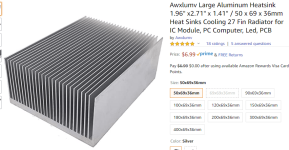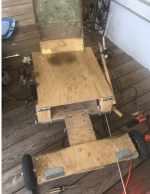dfrydman said:
maybe i should've said this before but i am not use a standard controller but a voltage regulator that can supply like 1000w at 24v so
Yes, you shoudl have said that. Unfortunatley it's really common for people to not tell the whole story, resulting in us giving bad advice. :/
If it is not a controller, but just a voltage regulator, it doesn't have a current limit in a way that's useful to preventing motor damage. (some adjustable power supplies do have current limiting, but they are not usually called "voltage regulators"...VRs typically only control voltage, not current).
So to correct that, this means you need to use a at least a 1000w or higher brushed motor, if you want to not have to keep buying new motors.
If you want to look up how all this stuff works, it may help you understand the dilemma you face. But essentially:
You have to use a motor that is *at least as capable* as the controller being used, if the loading allows the controller to output it's maximum power, becuase the controller is in charge of motor power--not the motor. (it's more complicated than that, but that's the basics--if the load is high enough, as in your case, the controller will output more than the motor can handle, because under the right conditions, a motor will draw nearly unlimited power, but can't use most of it so it ends up as waste heat.
If you use an under-capable motor with an over-capable controller, and then you put a load on the motor that causes the controller to supply more power than the motor was designed to handle, the motor will be damaged or destroyed. It may take time, but it will happen, just as it did to your present motor.
If your controller is capable of 1000w, it will supply that at startup from a stop every time, for however long it takes to get you to a speed where the motor spins fast enough to cause enough backflow of current to cancel some of that out.
If the motor is not designed to handle that kind of power, (or is not cooled sufficiently) it will overheat. If the motor is used at lower RPMs than it was meant for at that power level, it will still overheat even if it is rated for that power level, becuase it will still draw more power than it can handle.
One scenario for such a case, which sounds like what happened to you already:
The overheating will damage the windings, burning the enamel from them, and causing shorts inside the windings, which may either affect the speed/torque the motor can supply, or just plain burn it out by shorting across separate windings.
It will also damage the magnets if it gets hot enough, demagnetizing them a little each time, and causing the motor to spin faster with less torque for the same power it used to do slower and more torque with. So it will take more power to get the same torque, which will cause it to take longer to accelerate, which means more heat for a longer time, which then damages the windings and magnets even further, increasing the spiral of damage until the motor simply fails.
If your controller has a current limit adjustment, you can turn it down to what your motor is rated for, and this will let your motor survive. The kart will not perform like it did before, but at least your motor will survive.
If you want the same performance, but not destroy motors, you need a motor at least as capable as your controller.
Or you need sufficient cooling capacity for the existing motor to remove the 750watts (or however much) of excess heat, which is quite a lot of cooling capacity.
Some cooling is better than none...but you'd have to experiment to find out if any particular cooling scheme will work...if it's not enough, each motor used will continue to overheat....





